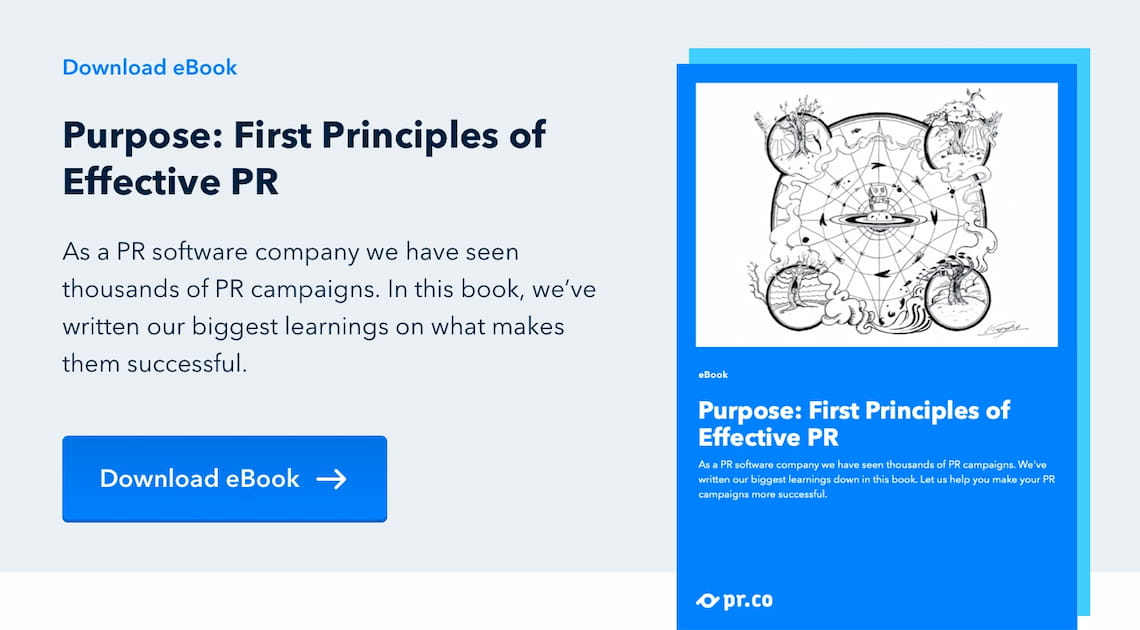The technology combining neurology and marketing is advancing. Before it becomes mainstream practice, there are some important, ethical questions to consider.

Embracing change is a natural part of our job as communicators.
Tech is a renowned bringer of change; and with the nascent field of Neuromarketing, the vast potential for change has been raising a few eyebrows.
The term ‘Neuromarketing’ was coined by Dutch professor Ale Smidts and has given birth to a wave of neuromarketing startups in the Netherlands. As a type of behavioral economics, neuromarketing uses techniques like brain scanning to study people’s emotional responses to marketing. How do people really feel about your PR or marketing campaign?
What seems like a gimmick may very well turn into mainstream practice.
To understand why we first need to zoom out a little.
Over the past 10 years, data has replaced oil as the world’s most valuable commodity. Digital platforms have dethroned the Shells and Exxons of the world and have become the new world's richest companies. Apple, Google, Amazon, Microsoft: they’re all running the show. And they’re doing it with your data.
Anyone who has had to deal with GDPR at work will know that data, and how it is used, is a tricky issue. But PR and communications professionals rely upon data to be effective. So in theory, using a technique (neuromarketing) that promises to make communication more effective by using better data seems like a no-brainer.
%20(1).jpg?width=736&name=329638-robina-weermeijer-igwG8aIaypo-unsplash-0ec260-original-1568107950%20(2)%20(1).jpg)
The benefits of neuromarketing
Neuromarketing combines neurology, psychology, and marketing to try and discover the true hearts of our audiences.
This is particularly interesting because humans, it turns out, are not so great at self-reporting. Put them in a market research group or give them a survey and- whether consciously or not- they tend to tell a fib or two.
A human’s perception of how others will judge them leads them to misreport their true feelings. This is why neuromarketing can be so useful: it can help reveal hidden thoughts and preferences. If you know the true rationale behind audience decisions, so you can tailor your communication to address their actual emotions.
Every brand wants to know what emotions their brand elicits. What is the real reason consumers pay attention to your marketing? Companies can finally identify what works and what will annoy the viewer.
Put more simply, neuromarketing looks at the whys and hows of consumer decisions.
The benefits are clear: communication efforts become more effective and there are fewer product failures. And you save money. It’s like very sophisticated A/B split testing, but beyond that, anyone with a passing interest in human behavior should find the discoveries intriguing.
.jpg?width=736&name=329637-matthew-t-rader-BjVaq1-bp0E-unsplash-52231d-original-1568107949%20(1).jpg)
How the technology works
Those who think that mind-reading sounds a little far-fetched would be right. However, there are numerous technologies that give very strong indicators of how someone is feeling. Here are the main techniques:
Eye-tracking technology
Eye-tracking technology tracks visual patterns like your point of gaze, how long you look at something for, when you blink, and how your pupils react. This gives a clear idea of where attention is won (or lost), what elements are missed, where your audience becomes distracted. This can give you a good indication of how to place your key messages in a way that will catch their attention.
The technology can be applied to many worthy causes: for example, it can warn you if you are going to fall asleep at the wheel and can help those with disabilities to use computers.
.jpg?width=736&name=329640-patrick-brinksma-ZMxbPRIPtWE-unsplash-b5a0a0-original-1568107950%20(1).jpg)
Functional Magnetic Resonance Imaging (fMRI)
Functional Magnetic Resonance Imaging (fMRI) or brain mapping is where neuroscientists map brain activity. They do this by looking at changes in blood flow, which is correlated with neuronal activation.
Data that comes from fMRI far outperforms other methods of predicting consumer behavior and has proved especially useful for things such as setting the pricing of products.
Emotion Response Analysis (ERA)
Emotion Response Analysis (ERA), uses EEG imaging to measure people’s emotions in response to stimuli. This involves placing electrodes at the surface of the scalp to measure electrical activity from the brain. By measuring emotions in real-time marketers have been able to accurately use emotion to ‘make your audience notice, remember, share, and buy.’
.jpg?width=736&name=329645-stem-t4l-MtnEvxP_4TI-unsplash-843a68-original-1568107963%20(1).jpg)
Biometrics
Finally, we have biometrics, which uses things such as heart rate, finger and facial scans can give insights into emotional and cognitive reactions. Facial emotion coding, after all, is how humans interact with each other.
Neuromarketing's biggest insights
Information overload sucks, so the mind of the consumer has learned to aggressively filter. Neuromarketing has given us insights into what catches people’s attention. It’s how we know that consumers are drawn to pictures of babies, that they like the color blue, that headlines that surprise the brain are more effective, and that some ‘power words’ get far more responses.
Neurologists have identified the elements that block the brain from making decisions, like decision paralysis. We are so overwhelmed by choice in the modern world that we often make no choice at all.
Framing helps with this paralysis by creating the illusion of a simpler choice. We also know from what we have discovered about loss that aversion that people prefer avoiding losses to receiving the same amount in gains. That’s why “buy before it’s gone” strategies are so effective.
Another neuromarketing discovery about pricing is that rounded numbers work when a decision is being made that is more emotional, and that complex figures are more effective when the logical brain is being used.
.jpg?width=736&name=329650-rajiv-perera-I4oipIl83BA-unsplash-0004df-original-1568108703%20(1).jpg)
Marketers and product designers then followed suit, realizing that humans respond more positively when rewards are embedded into products. Famously, social media like Facebook have played on this with features like the red button and the slot machine refresh on a newsfeed.
The cons of neuromarketing
And you’d be right. While it could be argued that all marketing is neuromarketing: after all, isn’t the testing we do on a company website just a way of discovering people's preferences (and optimizing for them)? All marketing wants to make people feel a certain way, so they will have a certain behavior.
But now that technology is advancing at such speed, these insights -and the influence they can have- are no longer a simple matter. The future of neuromarketing has an uncomfortable element.
What is a rational decision and how much can a person be influenced? Given the bad press tied up with psychological manoeuvers orchestrated by Cambridge Analytica, companies would be right to steer clear of anything that could be seen as an unconscious manipulation. The infamous phrase ‘pressing the buy button in the consumer’s brain’ used by some neuromarketers has not done a lot to calm people’s fears about brainwashing.
PR is reputation management and in the digital age, the risk to your brand reputation is very high. But, most importantly, manipulation is unethical.
.jpg?width=736&name=329636-modern-affliction-N_oekyJUeEI-unsplash-9e72ca-original-1568107945%20(1).jpg)
Recent developments turning the tides
Neuralink’s brain-machine interface
Elon Musk’s neurotechnology company ‘Neuralink’ has announced that it is developing a brain-machine interface, which involves sewing thin threads into the human brain, with the goal of one day helping the paralyzed use robotic limbs. But Musk’s aspirations extend further than healthcare; he also wants able-bodied people to communicate with machines more efficiently. With brain implants, we will effectively merge with AI.
Facebook’s mind-reading technology
The other noteworthy news item is Facebook's investment in mind-reading technology. BCI’s (brain-computer interfaces) can pick up thoughts from your neurons and translate them into words. Instead of the Neuralink-type threads, Facebook has been using people with epilepsy as their case studies as the participants already have devices implanted into the brain for medical reasons. Researchers say that, unlike fMRI which is studied after the fact, they can measure brain activity and its associated words in real-time. This means that a company that is not exactly renowned for being honorable with user data is now learning how to read our minds.
.jpg?width=736&name=329657-andy-kelly-0E_vhMVqL9g-unsplash-2e9d13-original-1568109308%20(1).jpg)
That doesn’t sound very ethical
That’s because it’s not. These two stories raise some serious questions about the future of neuromarketing. If marketers can enter brains without consent, privacy, manipulation, cognitive liberty are all legitimate concerns. It’s clear that regulations need to be put in place.
The George Orwell quote “Nothing was your own except the few cubic centimeters inside your skull.” has been recently resurrected, and with good reason. We do, after all, have the right to remain silent.
How do we safeguard privacy when people may not know their thoughts and emotions are being harvested as data? From a marketers perspective, people could be forced to buy products that bring no value to their life.
If we can work out how the brain makes decisions, we can, therefore, work out how to exert barely perceptible influence. If marketers are testing a subliminal technique, it’s very likely consumers will find themselves with preferences or buying products without a real sense of why they made that decision.
Should you be worried?
Although some helpful insights have been gleaned, it is important to take this technology with a pinch of salt. fMRI is still a new technology and the images it provides are not given in real-time.
Through the lens of an economist: If it truly does make marketing more efficient then the money saved could enter the economy in a much more helpful form, such as lower prices and better products.
Generally speaking, we know very little about the human brain compared to other parts of the body. The learnings we have gathered from the field of neurology so far, as with all science, are not 100% certain.
Correlation, as they say, does not always mean causation, especially when it comes to different brain functions and the areas that show overlap. Some have argued that this approach assuming the precision of brain activity without taking into account other things such as social factors is reductionist. There are infinite variables that condition behavior. What is the absolute truth?
.jpg?width=736&name=329639-ani-kolleshi-7jjnJ-QA9fY-unsplash-560f64-original-1568107950%20(1).jpg)
Rules and regulations
Nevertheless, some uncomfortable insights from both neurology and human psychology do suggest that the subconscious mind has an enormous impact on our behavior.
Neuroscientist Ap Dijksterhuis has likened the human mind to an iceberg, with the subconscious mind lying beneath the surface making up the lions share of thoughts and actions. People don’t often make purchasing decisions for entirely rational reasons.
An ethical and legal framework needs to be put into place to regulate this. Soon we will be talking about ‘neurorights’ so it’s important that as professional communicators we fall on the right side of the debate.
Thankfully, the NMSBA has already developed a Code of Ethics for the Application of Consumer Neuroscience in Business, in a bid to protect the privacy of research participants as well as restoring faith in the legitimacy and integrity of neuromarketers.
As people who work in PR and communications, we seek to influence as a profession. It is inevitable that effective techniques of persuasion become adopted.
Marketing by trade is a form of influence. However, we as an industry need to decide to what extent we wish to influence the decisions of our audience.

Conclusion
It is useful to differentiate between manipulation and persuasion. To manipulate is to force someone into behavior or decision that only benefits you and not them. Ie. Pushing someone to make a decision that they will likely come to regret.
To persuade, on the other hand, is to influence behavior in a way that is of mutual benefit to both you and your audience. In this way, you become a benevolent matchmaker between your product and consumers.
Thankfully, consumers are quite savvy and are already able to distinguish sophisticated persuasion techniques. However, unless they all become trained neuroscientists, it will become increasingly hard to discern when more subtle phycological techniques are being used. If communication is specifically designed to bypass our rational defenses then Houston, we’ve got ourselves a problem.
In communication, we talk about trust a lot. But If you want to regain trust from your audience, you have to be trustworthy. This involves being transparent, helpful, and yes, doing no harm.
Companies of the future will need to develop a clear set of parameters, like not testing on people under 18, or being more upfront about the techniques they are using.
As professionals, we wear the dual hats of being consumers and communicators, so we should be able to answer the concerns of both roles. As a consumer: how would you want your data to be used? And as a marketer: can you give a good response to consumer questions about ethics? If you can answer these questions you’re on the right track.
Carmen Guillen is Content Team Lead at OLIVER Agency. With over 7 years of experience as a copywriter and editor, Carmen has written for high-profile blogs and newspapers, and directed the content teams for fast-growing startups and NGOs, including PR.co’s blog and Unfold Magazine. Carmen is passionate about ethical business and artful storytelling.. Connect on LinkedIn or send an email







